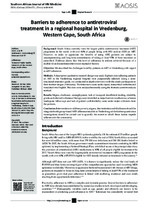| dc.contributor.author | Azia, Ivo N. | |
| dc.contributor.author | Mukumbang, Ferdinand C. | |
| dc.contributor.author | van Wyk, Brian | |
| dc.date.accessioned | 2018-06-06T08:54:40Z | |
| dc.date.available | 2018-06-06T08:54:40Z | |
| dc.date.issued | 2016 | |
| dc.identifier.citation | Azia, I.N. et al. (2016). Barriers to adherence to antiretroviral treatment in a regional hospital in Vredenburg, Western Cape, South Africa. South African Journal of HIV Medicine, 17(1): a476. | en_US |
| dc.identifier.issn | 2078-6751 | |
| dc.identifier.uri | http://dx. doi.org/10.4102/sajhivmed. v17i1.476 | |
| dc.identifier.uri | http://hdl.handle.net/10566/3775 | |
| dc.description.abstract | BACKGROUND: South Africa currently runs the largest public antiretroviral treatment (ART)
programme in the world, with over 80% of people living with HIV and/or AIDS on ART.
However, in order to appreciate the benefits of using ART, patients are subject to
uncompromising and long-term commitments of taking at least 95% of their treatment as
prescribed. Evidence shows that this level of adherence is seldom achieved because of a
multilevel and sometimes interwoven myriad of factors.
Objective: We described the challenges faced by patients on ART in Vredenburg with regard
to ART adherence.
METHODS: A descriptive qualitative research design was used. Eighteen non-adhering patients
on ART in the Vredenburg regional hospital were purposefully selected. Using a semistructured
interview guide, we conducted in-depth interviews with the study participants in
their mother tongue (Afrikaans). The interviews were audio-taped, transcribed verbatim and
translated into English. The data were analysed manually using the thematic content analysis
method.
RESULTS: Stigma, disclosure, unemployment, lack of transport, insufficient feeding, disability
grants and alternative forms of therapy were identified as major barriers to adherence, whereas
inadequate follow-ups and lack of patient confidentiality came under major criticisms from
the patients.
CONCLUSION: Interventions to address poverty, stigma, discrimination and disclosure should be
integrated with group-based ART adherence models in Vredenburg while further quantitative
investigations should be carried out to quantify the extent to which these factors impede
adherence in the community. | en_US |
| dc.language.iso | en | en_US |
| dc.publisher | AOSIS | en_US |
| dc.rights | © 2016. The Authors.
Licensee: AOSIS. This work
is licensed under the
Creative Commons
Attribution License. | |
| dc.subject | South Africa | en_US |
| dc.subject | public antiretroviral treatment (ART) | en_US |
| dc.subject | Level of adherence | en_US |
| dc.subject | Vredenburg | en_US |
| dc.subject | Western Cape | en_US |
| dc.title | Barriers to adherence to antiretroviral treatment in a regional hospital in Vredenburg, Western Cape, South Africa | en_US |
| dc.type | Article | en_US |
| dc.privacy.showsubmitter | FALSE | |
| dc.status.ispeerreviewed | TRUE | |
| dc.description.accreditation | ISI | |

